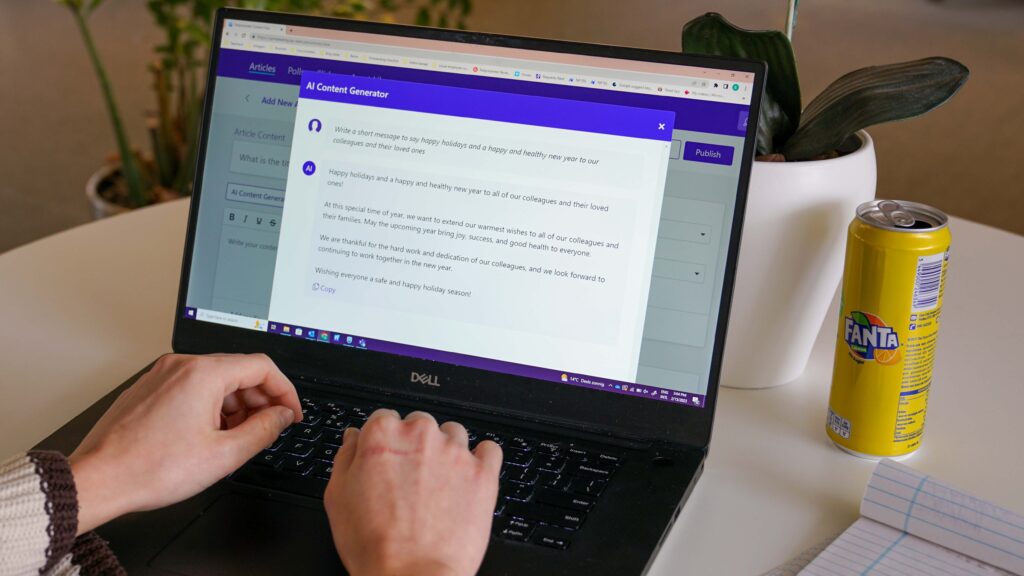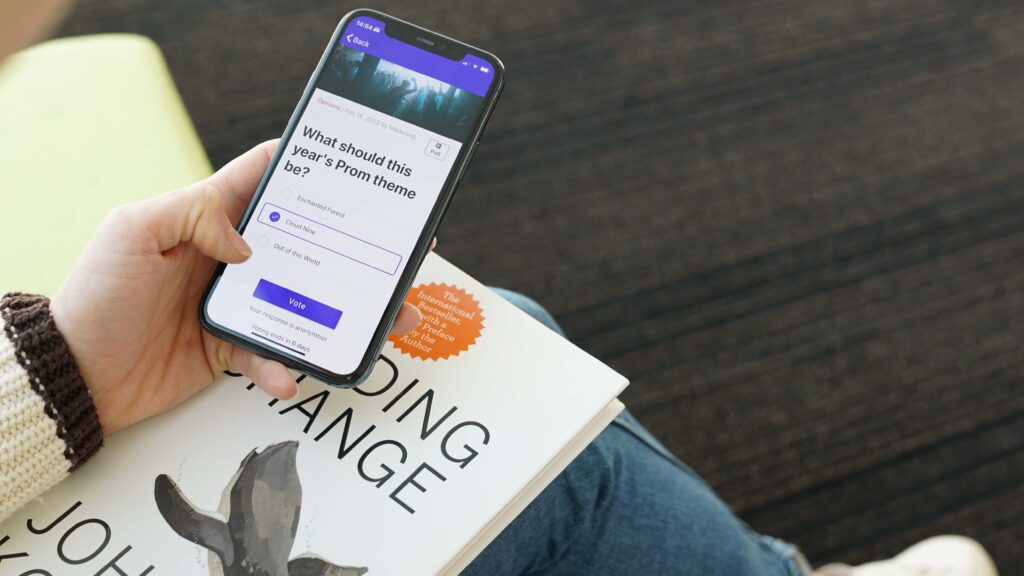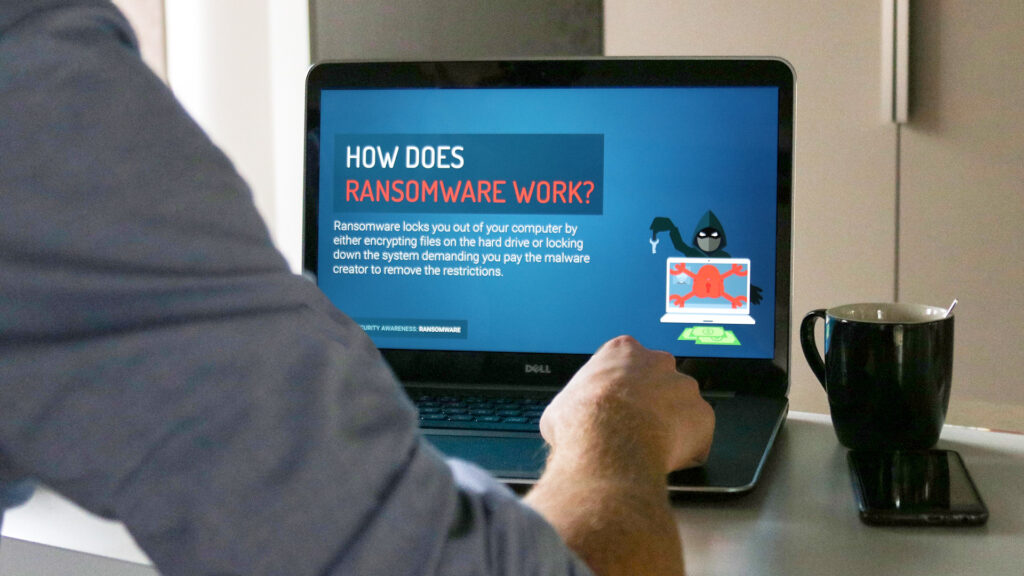Internal Communication Trends
Estimated reading time: 13 minutes
It’s time to look back at all 2022 internal communication developments leading to internal communication trends in 2023. In recent years, internal communication has been put on the map. In 2023, however, is less communication more? What is the future of AI in internal communication? And what about communication with remote employees? In short: in what direction will internal communication go in 2023?
Table of contents
- Internal communication trend 1: Streamline tasks with AI in internal communication
- Internal communication trend 2: More data-driven communication
- Internal communication trend 3: is less really more in 2023?
- Internal communication trend 4: Visual communication draws employees’ attention
- Internal communication trend 5: the importance of an online community
Internal communication trend 1: Streamline tasks with AI in internal communication
We really can’t ignore the first trend, as the internet has been full of it lately: Artificial Intelligence and OpenAI’s new chatbot – ChatGPT – in particular. Automated campaigns, a bot that creates content, and AI chat systems; just a few examples that show that AI hasn’t been a vision of the future for quite some time now – it’s here, ready to transform and streamline internal communications. Automatically recorded meeting notes, automatic translations or transcriptions, or automated scheduling are also AI features built into programs such as Microsoft Teams. Several applications are imaginable in this regard:
Overcome writer’s block; let AI create your content
As the volume of content we consume keeps growing, internal communicators face the challenge of fighting these distractions and competing for your employees’ attention. Trying to turn employee communication, which can often be a slightly ‘dry’ subject matter, into engaging content can be quite a challenge.
It’s a challenge content-writing AI such as ChatGPT can’t completely solve for communication teams. Still, it can definitely assist and inspire internal communicators. Look at AI as your personal internal comms assistant and rely on it to crush your writer’s block, generate larger volumes of content quickly and efficiently, translate content effortlessly into any language, and summarize it.
Then edit the content to ensure it’s not unwanted or inaccurate information, and tailor it to your organization, its events, and its audiences. An AI Content Generator with a built-in chatbot writes content quickly and easily; internal communicators craft the output into the desired information your employees need.
This approach demonstrates the future of AI in internal communications: humans and AI, hand in hand, working to streamline tasks and make them easier – yet continuing to deliver quality, emotional, and above all, human communications.

Automated chatbots to answer questions
To the question “How can you use AI in internal communication?”, ChatGPT’s answer starts as follows:
“Chatbots: Organizations can use chatbots powered by AI to assist employees with their day-to-day queries. This can help reduce the workload on HR and other departments, as chatbots can provide instant answers to frequently asked questions.”
This is one of the applications we would think of first ourselves, as many people’s first introduction to AI was AI in the form of AI assistants such as Alexa, Google Assistant, or Siri. They are examples of how AI consciously makes our lives easier.
These automated bots, in the form of chatbots, can also be integrated into organizations’ information facilities. They can then help answer frequently asked questions or make user searches more interactive and direct. The capabilities of these chatbots have already been proven: they successfully answer over eighty percent of all questions they are asked.
This is another way in which AI assists in and streamlines human labor. After all, you must put some effort into providing the chatbot with the right information. That way, it can provide employees with the right information specific to that organization. Once everything is tested and working, these AI-based chatbots can take a lot of work off your communication team’s hands, allowing them to focus on other tasks.
You can already see examples of this in Bing’s search engine, where a chatbot has been implemented. With this extra feature, you no longer need to search the internet yourself – you can quickly get to the desired result through questions and answers. The information finds you instead of the other way around. A similar system can be introduced into your internal communication strategy.
AI as a source of data analyzes communication patterns
In addition, AI can be used as a source of data: after all, chatbots (for example) can measure which questions are most frequently asked by employees and which problems are most common. If that data is tracked, the information can be turned into action points to adjust your communication strategy.
Internal communication trend 2: More data-driven communication
The last AI application takes us to a new trend for 2023. If you’re using AI to collect data anyway, you can also use this data to improve your employee communications. Communication platforms, email software, and intranet software often already display all kinds of information about various things, from how often employees open an email to what time of day they most often read a message.
Understanding your employees’ behavior can provide data on:
- How often do employees communicate with each other;
- How often do employees respond to emails or messages;
- At what times are certain messages read most often;
- What type of content is most popular;
- What questions do employees ask most often;
- Which documents are looked up most often;
- How each communication tool is used, to determine how these tools can be made better use of.
With information about employee behavior and internal communications, communication teams can decide what is needed to improve communications. For example: do you need other channels? More or less information? Do employees need certain content? With the right data, you can continuously adjust your communication strategy to keep it optimal. This helps you ensure your busy workforce only receives relevant information without unnecessarily distracting them from performing important tasks.
Besides using this, often automatically generated, data, simply asking your employees some questions from time to time remains important. How do they feel at work? What can you improve? Just ask them by using (anonymous) surveys or polls that you publish through an intranet or mobile or desktop app: this allows you to easily collect information about how your employees really feel. If you combine your staff’s answers with your other data, you get a complete picture of how to best provide your employees with information, where you need to accommodate them, and what needs to change in your internal communication strategy (and possibly even in your organization).

Internal communication trend 3: is less really more in 2023?
We’ve had a lot to communicate about over the past few years: changing lockdown measures, stricter hygiene regulations, work-from-home protocols, and related benefits. We have received an enormous amount of information, both at work and in our private lives – on top of the huge flow of information that was already circulating in your organization.
All of this news probably means that some employees have consumed more than enough information from time to time. It isn’t unlikely that some of your staff are dealing with an information overload, or employees simply don’t have the time to read it all. In this case, your comms teams are creating content in vain. Creating more relevant content could help you avoid this. Do all your employees really need all that information? Or could we find ways to ensure that everyone gets the information that’s actually relevant and important to them?
One thing is certain: in 2023, less is more when it comes to internal communication. This doesn’t mean that you should just stop communicating entirely. Comms teams are obviously still responsible for keeping employees informed of the goings-on within their organization. It’s more about deliberately embedding moments of silence where employees cannot be disturbed or interrupted by ‘important’ information.
Less is more in 2023
So in 2023, less is more. But what does that look like in reality? Timing is everything in internal communications: a content calendar or a communication schedule can help communication teams execute their strategy to perfection.
This year, include moments without communication in your content calendar – communication shouldn’t lead to extra stress; it should be relevant. Good communication, published at the right moment, can help your staff do their jobs better or feel more at home within your organization.
On the other hand – irrelevant information really just adds to the information overload and causes your employees to experience stress. According to a survey, the number of emails employees receive alone can lead to additional stress: lots of unread emails cause increased heart rate and blood pressure, said 92 percent of those surveyed. Seems obvious that you’d want to avoid that!
So as you start planning for the new year, take another look at your schedule and the relevance of all communication on it. Then, insert some periods of silence. For example: don’t publish news during lunch breaks – allow people to take a break in peace. Don’t publish on days when important projects are being finished. Publish less in overall busy weeks. Balance is key!
In addition, use other communication channels, such as digital signage, intranet, or an app for smartphones: basically, anything that allows employees to quietly consume information when they want to. That way, you avoid the stress of overflowing inboxes or the expectation that employees must respond immediately, and you create some space that your colleagues can use to focus on their work.
Internal communication trend 4: Visual communication draws employees’ attention
Social media platforms such as Instagram, Pinterest, Snapchat, and TikTok have made creating, sharing, and consuming visual content easier. These platforms continue to grow; 190 million new users joined social media in 2022. Understandably: social media gives their users a personalized feed on which they can scroll endlessly through attractive and free visual content. That visual content immediately grabs attention, and in many cases, people retain it better than textual information.
Moreover, today’s workforce includes a growing number of (young) workers who are used to this visual communication in their personal lives – and so they increasingly expect that kind of content in their professional lives. In this age of information overload, in addition to taking communication breaks, you can capture your staff’s attention using visual communication. So, in 2023, it’s time to use visual communication to reach your busy employees!
Visual communication can help various teams in your organization: your comms team, the HR department, your IT team, and even management. They can use visual communication to reach your employees effectively and quickly.
Convey messages concisely and appealingly with video
Use videos to make your management’s messages more personal and impactful. A short video is a good way to grab attention during a busy workday. Thirty to sixty seconds is enough! That may sound short, but it allows leaders to connect with employees without taking large chunks out of their day – and it’s still enough time to raise important issues.
Publish any video messages in a mobile app or an intranet, so employees can watch them whenever they have a moment. Much more personal than a long, formal email. Your HR and communications team can also use videos, infographics, and other visuals to convey information more effectively. For example, distribute onboarding content, courses or training, and important company information. Make data more insightful with dashboards on screensavers or narrowcasting screens, and explain changes within the organization using graphics and videos. Communicating information this way often increases reach and understanding.
Make your IT team’s messages more eye-catching
IT teams can convey all kinds of information better with visual communications. For example, cybersecurity campaigns become much more vivid with screenshots of a phishing email displayed repeatedly on narrowcasting screens, lock screens, or newsletters.
An important message about scheduled or unscheduled system maintenance can be much more effective if published via a short textual message with an eye-catching visual. Publish it through a desktop alert, a mobile app, or a company-wide teams or slack channel to grab attention. Or include a fun or playful GIF; it may not be the most professional idea, but it certainly attracts attention – and many of your colleagues will surely appreciate it and want to see it more often.
Software changes go more smoothly when you provide your employees with screenshots, flowcharts, or screencasts that explain the new software. If you create them once and store them somewhere everyone can find them, such as the intranet, your IT team can pay attention to other important issues.

Internal communication trend 5: the importance of an online community
This was a internal communication trend last year, and it continues to be in 2023 – communication in the hybrid workplace. In the coming years, hybrid work will go from hybrid to fully remote for a lot of people. Sixteen percent of the world’s organizations were completely remote by 2022. That seems like a low number, but it gets more impressive once you consider 44 percent of organizations have no remote working capabilities.
Full remote work has gained popularity with more and more people: it currently allows about 35 million people around the world to choose wherever and whenever they prefer to work. And it’s a number that’s expected to keep growing in the future as more and more people recognize the benefits of the fully remote lifestyle.
A way of working that started out of necessity during the pandemic has grown into a real movement. People are looking for a better work-life balance and more freedom in their lives. However, reaching and connecting all of these employees in so many different places is very difficult and it makes the importance of a strong online community even bigger.
Visual communication creates connection
How do you make communication most personal for employees working remotely? Through images! If you rarely or perhaps never see your colleagues in real life, there will always be a distance that is much easier to bridge with physical collaboration. But – to still build the team spirit it takes to complete tasks well and to make the teamwork work, visuals can be very effective.
Think of video meetings that are used to discuss important information – you could also use them for water cooler chatter. Give your employees a chance to connect with each other as they would on social media, for example, by giving them a communication platform with lots of opportunities to interact. A desktop or mobile app or an intranet with a comment section can provide the necessary team spirit.
Install corporate screensavers, wallpapers, or lock screens on laptops and continually run information on them that creates connectedness. Visual communication such as pictures from the beach where your colleague from marketing is currently working, the surf session your sales colleague had over the weekend, or the view of that beautiful street in Barcelona that your colleague from HR has from their balcony. In doing so, you give employees a glimpse into the lives of their colleagues and provide the necessary conversation material about each other’s lives. Working from the office? In 2023, the office is everywhere – and internal communication provides the necessary connection and togetherness!
This year, employees’ needs are shifting: we want less information, more freedom, work more efficiently, and a better work-life balance. Communication teams can do a fantastic job of capitalizing on these internal communication trends and helping their colleagues arrange their lives the way they want. With the help of all kinds of useful tools and AI, they will once again provide the connection needed to complete tasks and goals, from wherever they are. Working anywhere in the world while staying efficiently informed? Welcome to 2023!
Get in touch with our consultants or request a demo to start keeping your employees informed, engaged, productive and safe. Or download our free infographic to get started with digital signage.

